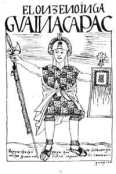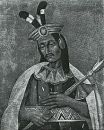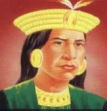Hello! This is part twenty one of a multi-part series on the Inca Empire and the Conquistadors. If you want some background, the introduction to this series is right here, and part twenty is here. For those of you who like to have no idea what’s going on, go ahead!
With the defeat of Diego Almagro II in 1542, the last of the Almagros had been crushed. The Pizarros had won, defeating Almagro and his men but at great cost to them – Pizarro himself was dead, joining his brother Juan, and Hernando was locked up in prison in Spain. Gonzalo Pizarro was the last brother standing, and his battles weren’t over yet.
From 1535 – 1537 Peru had been torn with battles between the conquistadors and the Incas. Then, from 1537 – 1542, the conflict had erupted between the conquistadors themselves. Now, from 1544 – 1548, a battle for Peru would ignite between the conquistadors and the representatives of the crown.
Vaca de Castro was the first royal governor to have never been a conquistador – unlike Pizarro and Almagro, he had not fought against the Incas – but he governed fairly and was generally regarded well during his reign from 1542-1544 by the inhabitants of Spanish Peru.
However, the next man to arrive would engender no such love.
Blasco Nunez Vela landed in Peru in 1544. Nunez Vela was the first viceroy of Peru, appointed by the crown. From the moment he arrived Nunez Vela’s brusque and dismissive attitude rubbed the conquistadors the wrong way. That alone caused friction between Nunez Vela and his subjects.
But much worse were the reforms Nunez Vela brought, because he came with orders from King Charles V to enforce the New Laws in Peru. The New Laws were an attempt by noted humanist Bartholome de la Casas to alleviate the suffering of the native population. Chief among them was the dissolution of the encomienda system and a removal of all the natives from the conquistadors and putting them under the protection of the crown.

As can be imagined, these laws were not popular in Peru. Bartholome de la Casas’ laws were intended to protect the native peasants from the depredations of the conquistadors, but the conquistadors saw the New Laws as a blatant attempt to rob them of the spoils of conquest. The natives were essentially the slaves of the conquistadors, and their labor was key to the conquistadors living in comfort. Any attempt to protect the natives was, in the eyes of the conquistadors, depriving them of valuable property. Making matters worse was the fact that Nunez Vela was not one of the conquistadors, and was essentially taking away property that they had won by force, while he had risked nothing. As the New Laws were enforced Spanish Peru began to seethe. According to de la Vega, “Blasco Nunez was already so detested by everyone that on his account the very name of viceroy was then as odious in Lima as that of king had been among the Romans.” (de la Vega loc. 22801)
Gonzalo Pizarro watched these developments with interest. The leading men of four prominent cities, including Cuzco, petitioned Gonzalo to represent their interests in front of Nunez Vela, and perhaps negotiate an easing of these laws. With that in mind, the cities elected Gonzalo the procurator general, (de la Vega loc. 22872) and Gonzalo began the long journey to Lima to meet with Nunez Vela. Armed with a sliver of authority, Gonzalo also brought with him four hundred heavily armed men for the “negotiations,” which may not have been exactly what the citizens had expected. (de la Vega loc. 22955)
Before he marched, Gonzalo wrote letters to all the leading men of Peru, asking them for their support. He planned to seize the governorship of Peru, which he claimed as his right as the last of Pizarro’s family still left in Peru. He also offered his full support, military and economic, to any man who supported his claim. Especially in Peru, this was not a small offering – everyone who received one of those letters would have remembered how generous Pizarro was with his men and how callously he treated those who turned against him. Finally, of course, Gonzalo offered to destroy the hated Nunez Vela and burn the New Laws from the soil of Peru.
As Gonzalo marched on Lima, he slowly abandoned all pretense of this being a peaceful visit. His soldiers closed the roads, waylaying messengers who were affiliated with the royalists. Nunez Vela was not idle in the face of this threat, and he sent both diplomats and scouts out to Pizarro to try and treat with him diplomatically and ascertain the strength of his forces. Unfortunately for Nunez Vela, his diplomats were turned away, and his scouts began to desert to Gonzalo. The scouts, just like Gonzalo, were not fans of the New Laws or Nunez Vela either. Gonzalo was openly rebelling against Nunez Vela, and the closer he got to Lima, the stronger his forces grew.
Dates
c. 1200 Kingdom of Cuzco is founded
1438-1471 Reign of Pachachuti
1471-1493 Reign of Tupac Inca
1492 Columbus discovers the Americas
1493-1527 Reign of Huayna Capac
1526 Pizarro and his thirteen men discover the Inca city of Tumbez
1527 Huayna Capac dies of smallpox brought by the Europeans
1527-1531 Civil war between Atahualpa Inca and Huascar
1531 Pizarro’s conquering expedition to Peru, Pizarro captures Atahualpa Inca, Atahualpa executes his brother Huascar
1533 Pizarro executes Atahualpa Inca and installs Manco Inca as the new Inca
1535 Pizarro founds the city of Lima
1536 Manco Inca rebels against the Spanish, leads a massive uprising that traps them in Cuzco and Lima. Juan Pizarro is killed in the battle
1537 Diego Almagro seizes Cuzco from the Pizarros. Manco Inca retreats from the capital to Vilcabamba
1538 Hernando Pizarro defeats and executes Almagro
1540 Hernando Pizarro is sentenced to twenty years imprisonment in Spain for killing Almagro.
1541 Pizarro is assassinated by supporters of Almagro
1544 Manco Inca is assassinated by Pizarro’s assasins. Gonzalo Pizarro rebels against the viceroy Blasco Nunez Vela
Characters
Incas

Huayna Capac – Emperor of the Incas [Died of plague in 1527]

Huascar – Son of Huayna Capac and the heir to the throne [Executed by Atahualpa in 1531]

Atahualpa – Brother of Huascar and rival for the throne, emperor of the Incas [Executed by Pizarro in 1533]

Manco Inca – Younger brother of Atahualpa and Huascar, emperor of the Incas [Assassinated by Pizarro’s killers in 1544]
The Pizarros

Francisco Pizarro – Oldest of the brothers and mastermind of the expedition. A talented leader of men and a good strategist [Assassinated by Diego Almagro II’s men in 1541]
Hernando Pizarro – Second of the brothers; a canny and calculating tactician [Sentenced to twenty years in prison in Spain in 1540]
Gonzalo Pizarro – Third brother; charming womanizer with a vicious cruel streak
Juan Pizarro – Youngest of the brothers and a powerful, impetuous soldier [Killed during the Siege of Cuzco by Manco Inca’s forces in 1536]
Almagristas

Diego Almagro – Partner with Pizarro and one of his oldest friends, a hardened veteran of many battles ready to strike it rich [Executed by Hernando Pizarro in 1538]
Diego Almagro II – Almagro’s son, a hot-headed young soldier [Defeated by Gonzalo Pizarro and Cristobal Vaca de Castro’s forces and executed in 1542]
Royalists
 Cristobal Vaca de Castro – Viceroy of Peru, a flexible and adaptable man
Cristobal Vaca de Castro – Viceroy of Peru, a flexible and adaptable man
 Blasco Nunez Vela – Viceroy of Peru, grating and brusque administrator
Blasco Nunez Vela – Viceroy of Peru, grating and brusque administrator
 Pedro de la Gasca – Viceroy of Peru, a clever politician and adept manipulator
Pedro de la Gasca – Viceroy of Peru, a clever politician and adept manipulator
One thought on “Chapter 21: The King’s Man”